Forces and Motion | Term 1 Unit 2 | 6th Science - Motion and Rest | 6th Science : Term 1 Unit 2 : Forces and Motion
Chapter: 6th Science : Term 1 Unit 2 : Forces and Motion
Motion and Rest
Motion and Rest
1. What is rest? What is motion?
2. Is Mohan in motion?
3. How things move?
4. What happens when we apply a force on an object?
5. Types of motion
6. Periodic and non-periodic motions
7. Speed Vs Slow ?
8. Uniform and non-uniform motion
1. What is rest? What is motion?
Suppose there is a
book on your table right in the middle. Is the book moving? You will say “it is
not moving; it is at rest”. If you push the book to one side of the table to
clear space for keeping your notebook, then you will say the book is moving.
When the book was
at the same place with respect to the table, you say the book was at rest; but
when it was pushed from one place on the table to another place, you say it was
moving.
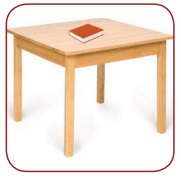
Activity
1
Can
you identify whether it is push or pull that results in motion in the following
cases?
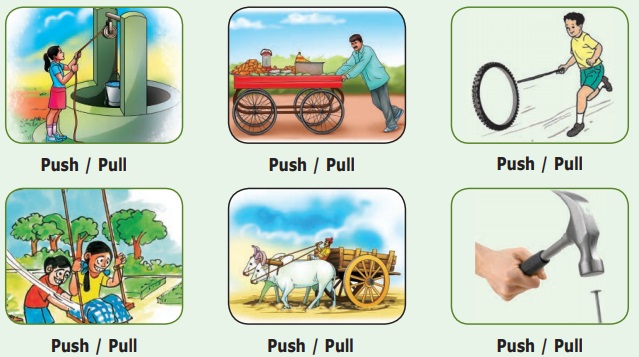
When there is a change of position of an object with respect to time, then it is called motion, if it remains stationary it is called rest.
Answer
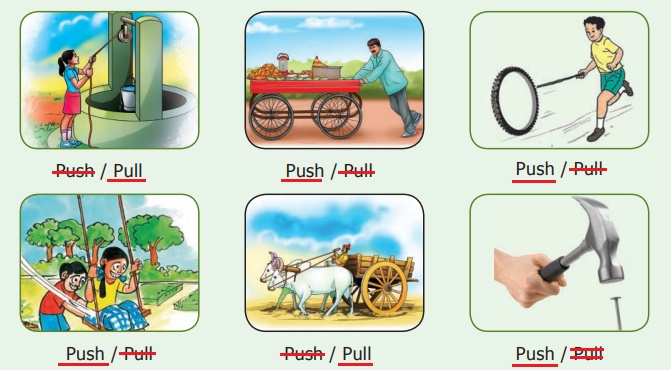
2. Is Mohan in motion?
Observe the
following pictures and say whether Mohan is in motion or at rest
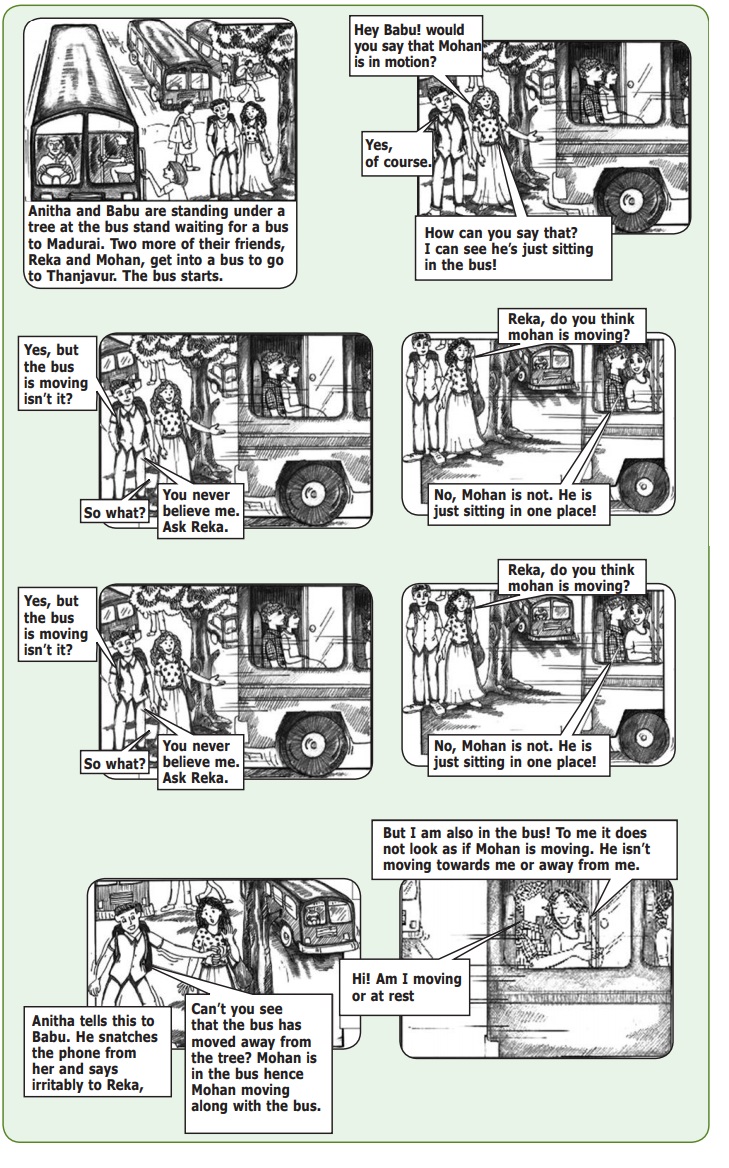
Discuss: Who is correct? Is Mohan really in motion?

We can readily
observe that both Reka and Babu are correct. From the point of view of Babu,
Mohan along with the bus is in motion; but for Reka who is sitting beside him,
he is at one place; therefore stationary. So, according to Babu, Mohan is in
motion; Mohan is at rest from Reka's observation. Can you think any other
examples?
Hi! Please answer
honey by observing the situation in the picture

Event 1: The man in the boat is moving with
respect to the bank of river. He is at rest with respect to the boat.
Event 2:
The girl on the swing is rest with respect to the seat of the swing.
She is with moving respect to the garden.

Event 3: Nisha is going to her grandmother's
house by bicycle. The girl on the bicycle is moving with respect
to the road.
She is rest with respect to the bicycle.
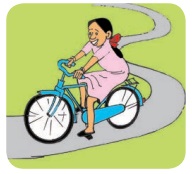
Take the case of a
book on a table at rest. Is it really without any motion? We know that Earth is
rotating on its axis; therefore the table along with the book must be rotating.
Is it not? We are also moving along with the earth. Therefore, from the point
of view of ground on which we stand, the book is at ‘rest’. Similarly, while travelling in a speeding bus, we feel
that the poles and trees seem to move backwards, and the things inside the bus
are stationary.
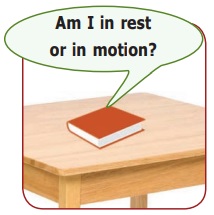
An object may
appear to be stationary for one observer and appear to be moving for another.
An object is at rest in relation to a certain set of objects and moving in
relation to another set of objects. This implies that rest and motion
are relative.
Activity
2
Moon or Cloud?
Observe
the moon on a windy night with a fair bit of cloud cover in the sky. As a cloud
passes in front of the moon you sometimes think it is the moon which is moving
behind the cloud. What would you think if you were to observe a tree at the
same time?
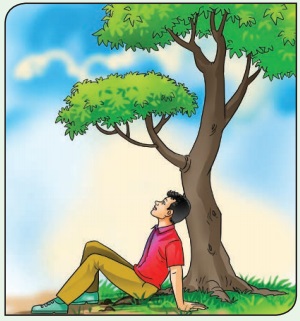
Answer:
It is a common illusion, caused by a combination of a bright moon
and thin, dim clouds (usually moving fast). Your eye/brain has trouble processing
difference of distance, especially in the sky, and so perceives the dim clouds as
being further away than the bright moon.
Aryabatta, an ancient Indian astronomer, said that like
the banks of the
river appear to move back to a person in a boat floating gently in a river, the
night sky studded with stars appear to move from east to west
while Earth rotates from west to east. Learn more by asking others and reading
up on your own.

3. How things move?
When we kick a ball
it moves. When we push the book on the table, it moves. When a bullock pulls
the cart moves. Motion occurs when the object is pulled or pushed by an agency.

In daily life, we
pulled out water from the well, with bucket or “the animal pulls a bullock
cart”. It is a person or animal, that is an animate agency that does the
pushing or pulling.
Sometimes we see a
tall grass in the meadow dancing in the wind, a piece of wood is moving down a
stream. What pushes or pulls them? We know that blowing wind and flowing water
is the cause. Sometimes the push or pull can be due to the inanimate agency.
Forces
are push or pull by an animate or inanimate agency.
Contact, Non-Contact Forces
In all the above
cases, the force is executed by touching the body. so, these type of force is
called Contact Force.
Mysteriously ripen
coconut falls to the ground. What pulls it to the ground? We would have heard
of the ‘force of gravity’ of Earth. Gravity pulls the ripen coconut from the
tree to the ground.
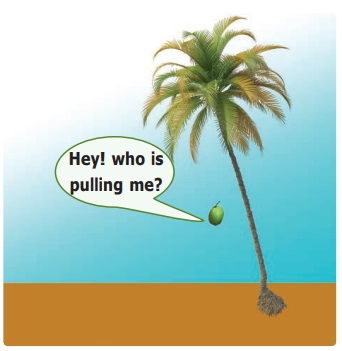
Bring a magnet near
the small iron nail. Suddenly the nail jumps into the air and sticks with the
magnet. Observe that the magnet and the nail did not touch each other. Still,
there was a pulling force that made the nail to jump towards the magnet. In
these two examples, the force is applied without touching the object. Such
forces are known as "non-contact forces"
Forces can be
classified into two major types; contact and non-contact forces. Wind is making
a flag flutter, a cart pulled by a bullock are contact forces. Magnetism,
gravity are some examples of non-contact forces.

4. What happens when we apply a force on an object?
What happens when
you apply a force on an object? Say you push a book on the table. The book
moves. Application of force in an object results in motion from a state of
rest.

What happens when a
batsman hit a ball? The ball is already in motion, but with the strike, the
speed of the ball increases. Moreover the direction of the ball changes. Application
of force on object results in a change in its speed and change in its
direction.
Crush a balloon, apply force on roti dough, pull a
rubber band. In these cases the shape of the object change on application of
force. Application of force in object results in expansion or contraction.
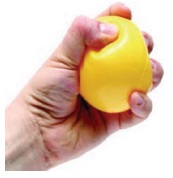
Look at this
picture. The person is applying force to stop the cart from moving. When the
force is applied against the direction of the motion, the speed can be reduced,
or even the motion stopped completely.
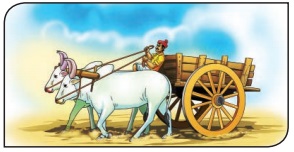
Discuss what
happens when you apply break in a speeding bicycle.
In a nutshell, the
applied force is an interaction of one object on another that causes the second
object to move from rest, or speed up, slow down, stop the motion, change the
direction, compress or expand.
Forces can
1. Change the states of body from rest to motion
or motion to rest.
2. Either change the speed or direction or both of
the body.
3. Change the shape of the body.
Activity
3
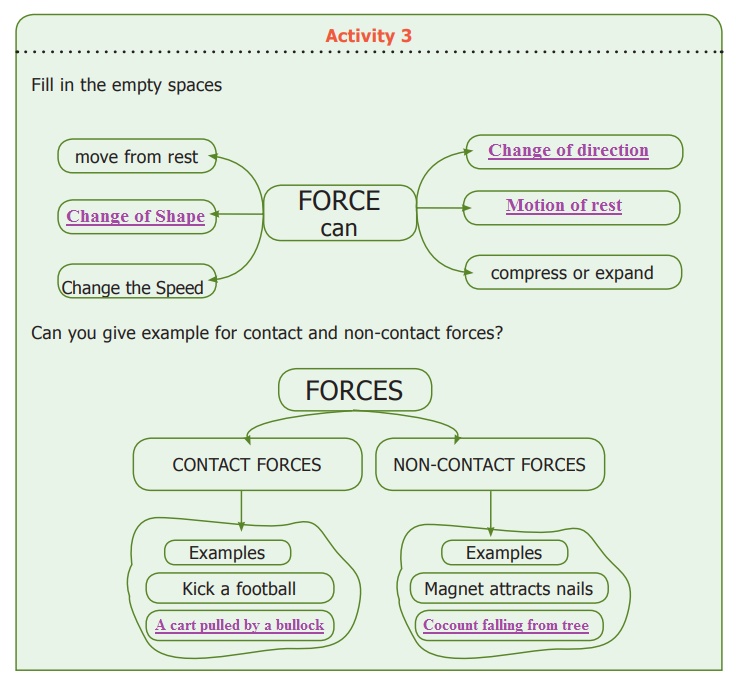
5. Types of motion
Activity
4
Play
with pencil
Please
do what Shanthi did...
(i). Shanthi took a pencil and
sharpened it with a sharpener. (ii) Then she drew a circle using the pencil and
a compass. (iii) Later she took her ruler (scale) and drew a straight line in
another paper. (iv) Then she kept the pencil between her finger and moved it
back and forth.

Now, look at the motion of the
pencil in all these four cases. How was it?
i. In the first case, the pencil rotated in its axis.
ii. In the second case, it went in a
circle.
iii. In the third case, the pencil
travelled in a straight line.
iv. Fourth case, the pencil tip
moved back and forth, that is it
oscillated like a swing.
That is its motion
was ‘rotational’ and then ‘circular’ ‘straight line or linear’ and later
‘oscillatory’.
Throw paper
aeroplanes or paper dart. Watch its flight path when you throw it at an angle.
The path curves i.e the paper flight is moving ahead but direction is changing
while moving such paths are called curvilinear.

6. Periodic and non-periodic motions
A fly buzzing
around the room is a combination of all these and flight path is zigzag.
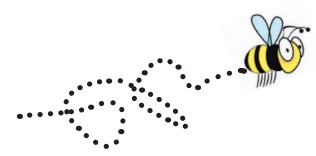
You
can classify the motion according to the path taken by the object.
a. Linear-
moving in a straight line, like a person walking on a straight path, free fall.
b. Curvilinear
- moving ahead but changing direction, like a throwing ball.
c. Circular
-moving in a circle, swirling stone tied to the rope.
d. Rotatory
-The movement of a body about its own axis, like a rotating top.
e. Oscillatory
-coming back to the same position after a fixed time interval, like a pendulum.
f. Zigzag
(irregular)- like the motion of a bee or people walking in a crowded street.
Oscillations
at Greater Speed
Ask your
friend to hold the two ends of a stretched rubber band. Strike it
in the
middle. Do you see it oscillates very very fast? When the oscillation is very
swift, it is called as vibration.
Fast
oscillations are referred to as vibrations.
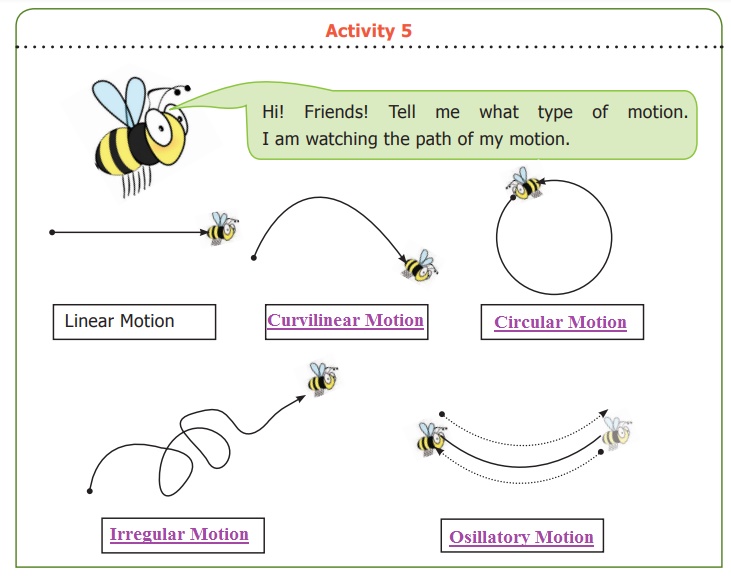
Activity
6
Classify
the following according to the path it takes.
Linear
,Curvilinear, Circular,Rotatory,Oscillatory, Zigzag (irregular)
* A sprinter running a 100 m race
* A coconut falling from a tree
* striking a coin in a carom board
game
* Motion of flies and mosquitoes
* Beating of heart
* Children playing in a swing
* The tip of hands of a clock
* Flapping of elephant’s ears
* A stone thrown into the air at an angle
* Movement of people in a bazaar
* Athlete running around a track
* Revolution of the moon around the
earth
* The movement of a ball kicked in a
football match
* Motion of a spinning top
* Revolution of the earth around the
sun
* Swinging of a pendulum
* Children skidding on a sliding
board
* Skidding down a playground slide
* Wagging tail of a dog
* Flapping of a flag in wind
* A car driving around a curve
* Woodcutter cutting with a saw
* Motion of water wave
* Motion of piston inside a syringe
* Bouncing ball
[add five motions you
observe to this list
Answer:
A
sprinter running a 100 m race - Linear motion
A
coconut falling from a tree - Linear-motion
Striking
a coin in a carom board game - Linear motion
Motion
of flies and mosquitoes - Zigzag (irregular) motion
Beating
of heart - Oscillatory
motion
Children
playing in a swing - Oscillatory motion
The
tip of hands of a clock - Circular motion
Flapping
of elephant's ears - Oscillatory motion
A
stone thrown into the air at an angle - Curvilinear motion
Movement of people in a bazaar - Zigzag (irregular)
motion
Athlete
running around a track - Circular motion
Revolution
of the moon around the earth - Rotatory motion
The
movement of a ball kicked in a football match - Curvilinear motion
Motion
of a spinning top - Circular motion
Revolution
of the earth around the sun - Rotatory motion
Swinging
of a pendulum - Oscillatory
motion
Children
skidding on a sliding board - Linear motion
Skidding
down a playground slide - Linear motion
Wagging
tail of a dog -
Oscillatory motion
Flapping
of a flag in wind - Oscillatory motion
A
car driving around a curve - Curvilinear motion
Woodcutter
cutting with a saw - Linear motion
Motion
of water wave -
Linear motion
Motion
of piston inside a syringe - Linear motion
Bouncing
ball - Linear
motion
Swirling stone tied
to the rope - Circular motion
Person walking on a
straight path - Linear motion
Throw paper aeroplanes
at an angle - Curvilinear motion
Moving in a circle -
Circular motion
Throwing ball - Curvilinear
motion
7. Speed Vs Slow ?
Take the case of the hour- hand of a
clock. In one day it makes two rounds. Look at a
bouncing ball. It bounces a certain number of times for a given
time interval or period. Look at the water waves, in a given
period that is a time interval; a fixed number of waves hit the
shore.

Motion repeated in equal intervals of time is
called as periodic motion.
Let us take the example of sabing swing in wind.
This motion is not in uniform interval. Such Motions are called non-periodic
motion.
Can you notice an interesting fact? Do
you notice that all oscillatory motions are periodic, but not all periodic are
oscillatory?
Revolution of the
moon around the earth is periodic but not oscillatory. However, the children
playing in a swing is both periodic and oscillatory.
Look at the tall
tree. When the wind is gentle, its branches are dancing slowly; but if the
gentle wind becomes strong, the branches shake violently, and if the speed
increases further, the branch may even break and fall. That is the motion can
be slow or fast.
Can we say a motion
is slow or fast without comparing anything?

Compared to
walking, cycling is fast, but a bus is faster than a cycle.
The aeroplane is
much faster than a bus.
So, slow or fast is
a relative concept which depends upon the motions we are comparing.
Then how to we say
a body moves in a particular Speed?
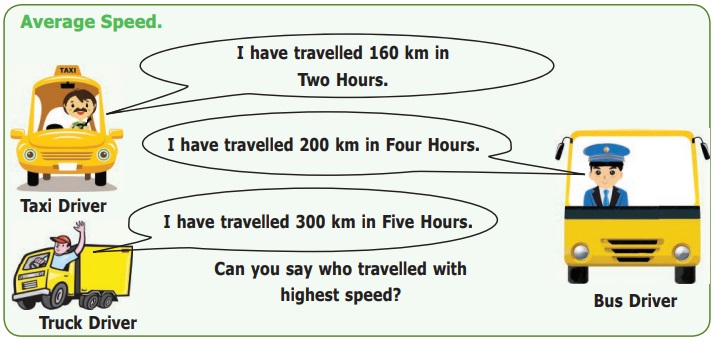
How do we say? Let us calculate how long they
travelled in One Hour?
Distance travelled by the Car in One Hour = 80 Km (160/2)
Distance travelled by the Bus in One Hour =
Distance travelled by the Truck in One Hour =
Have you found out? say now.
Fastest Car, Slowest Bus.
Have you noticed that saying who is fast and slow?
is easy when we calculate the distance they travelled in one hour.
Yes, it is easy when we calculate
the distance they travelled in one hour.
The
distance travelled by an object in unit time is called average speed of the
object.
If an
object travelled a distance (d) in time (t) then its
Average
speed (s) is = distance travelled / time taken = d/t.
In other words, you
divide the distance travelled by the time taken to get the speed.
Suppose a car
travels 300 km in one hour. Then we say the speed of the car is ‘300 kmph’ (we
read it as ‘three hundred kilometres per hour’).
If an object
travelled 10 metre in 2 seconds, then
Average speed (s)
= distance travelled
(d) / time taken (t)
= 10 metre/ 2 second
= 5 metre / second
bus takes three
hours to cover this distance of 180 kilometres. Then its average speed is
Average speed (s)
= distance travelled (d) / time taken (t)
= 180 kilometre/ 3 hour
= 60 kilometre / hour
Please note that metre/second or kilometre/hour
comes next to our answer for average speed. What is it?
Observe the formula for average speed. If we
denote the distance in metre and time by seconds then the unit of average speed
is metre/second.
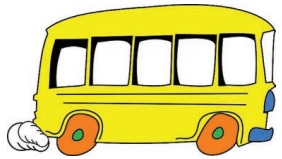
If we denote the
distance in kilometre and time in hour then the unit of average speed is
kilometre/hour.
Some times we use
units like centimetre/second.
In science we
generally use SI units. In SI units the unit of distance is metre and the unit
of time is second. So, the SI unit of average speed is metre/second.
Let us Calculate
1. A cat travelled
150 metres in 10 seconds, what is its average speed?
Solution:
Average speed (s) = distance travelled (d) / time taken (t)
= 150 metre/ 10 second
= 15 metre / second
2. Priya ride her
bicycle 40 km in two hours. what is her average speed?
Solution:
Average speed (s) = distance travelled (d) / time taken (t)
= 40 km / 2 hour
= 20 km / hour
Our Speed...
Let us play a small
game. Go to the playground with your friends. Mark 100 metre distance for a
race. Conduct a friendly running race and calculate the time they taken to
complete the distance by stopwatch. Now fill up the following table.

Usain
Bolt crossed 100metre in 9.58 seconds and made a world record. If you have the
hope to run in a speed above that speed.
Then Olympic Gold Medal is waiting for you.
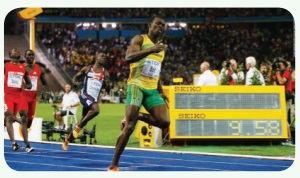
If you know the speed and the time
taken by the object travelled, then we can compute how much distance it had
travelled?
Speed =
distance travelled / time taken
(s = d/t)
s =
d/t or st = d
therefore the
distance travelled is speed × time.
If a ship travelled
at a speed of 50 kmph and it sailed for five hours, how much distance it had
travelled.
s =
50 kmph; t = 5 therefore
s × t
=
50 kmph × 5
h =
250 km
If we know the
speed and distance travelled we can compute the time taken.
s =
d/t that is t = d/s
time taken =
distance travelled / speed
Suppose a bus
travels at a speed of 50 kmph and has to cover a distance of 300 km. How much
time will it take?
t =
d/s that is 300 km/50 kmph = 6 h.
Compute the following Numerical Problems.
1. If you travel 10 kilometres in 2 hours, your
speed is 5 km km per hour.
2. If you travel 15 kilometres in 1/2 hour, you
would travel 30 km km in one hour, and your speed is 30 km.
km per hour.
3. If you run fast at 20 kilometres per hour for 2 hours, you will cover 40 Km.
FACT
FILE
A
Cheetah is the fastest land animal running with an average speed of 112 km/h
8. Uniform and non-uniform motion
Suppose a train
leaves Thiruchirapalli and arrives at Madurai. Is the train travelled in an
uniform speed? First, the train was stationary. When the train left the
station, the motion was slow and only after it left some distance that it
gathered speed. After that it slowed down while crossing bridges and stop at
intermediate stations for passengers. Finally, as the train approached Madurai,
again, it slowed and finally came to a halt. That is the speed was not same all
through the journey time. That is the speed was non-uniform. This motion is
said to be non-uniform motion.
In a
nutshell, we can classify the motion in terms a) path b) if it is periodic or
not c) if the speed is uniform or not. However, in real life, the motions are
combinations many types.
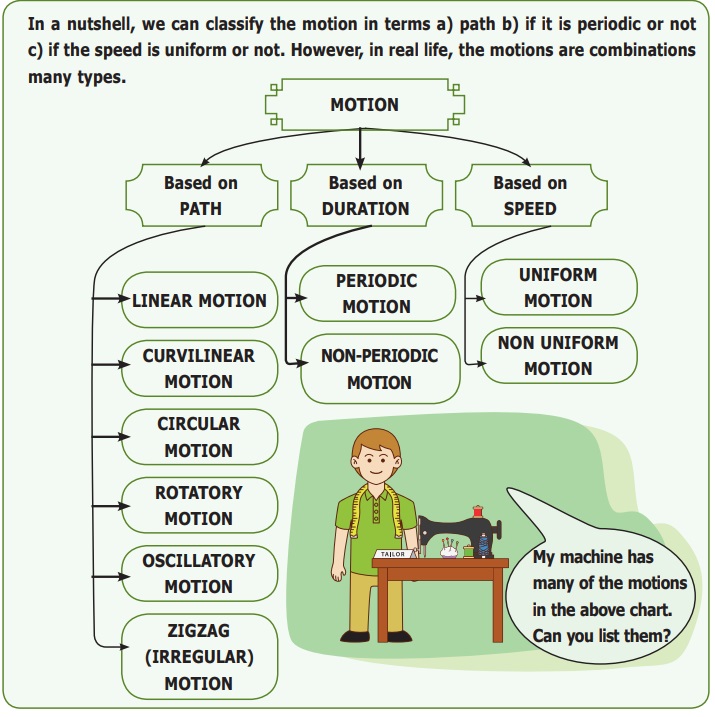
However, in between
the journey, there may have a stretch where in the train might have been going
at a constant speed. During that interval the train was moving at uniform
speed, that is uniform motion.
If an
object covers uniform distances in uniform intervals then the motion of the
object is called Uniform Motion. Otherwise the Motion is called Non-Uniform
Motion.
Many motions we see
in our day to day life are non-uniform. We will learn more about uniform and
non-uniform motion in later classes.
Multiple Motion
Look at the
bicycle. What type of motion does the wheel perform? What type of motion does
the cycle in total perform?
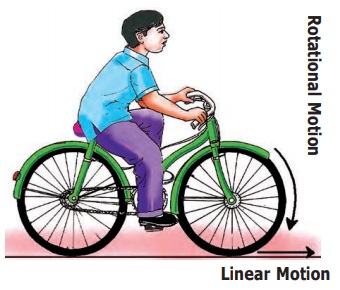
The tyres rotate
and make a rotatory motion, but the cycle as such moves forward in a linear
path.
Multiple
Motion in a Sewing Machine

* Motion of the needle
* Motion of the wheel circular motion
* Motion of footrest oscillatory motion
Related Topics